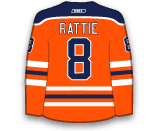



Niemi opened the season in Pittsburgh but was claimed off of waivers when Roberto Luongo was hurt and now that he is back, Niemi was waived again and claimed by Montreal who are currently without Carey Price and Al Montoya. Niemi is likely just insurance and will be nothing more than Charlie Lindgren’s backup. He heads to Montreal with a 6.74 GAA and .822 SV% in give games this season. Yikes.


Streit was a healthy scratch for the last two games and was placed on waivers this afternoon, so it looks like his time with the Canadiens will be cut short after just two games. At this point, letting Andrei Markov walk in favour of fellow veteran Streit isn’t looking so good for Montreal.

Cracknell played 8:35 TOI in the Stars’ second game of the season and was placed on waivers shortly after. He’ll join the Rangers where he will be in a similar role of depth forward. He had 10 goals and six assists (16 points) in 69 games with Dallas a season ago.

Nemeth has appeared in 108 NHL games and 57 AHL games with the Stars organization since 2013-14. Last season he had just three assists in 40 games with Dallas. The 25-year-old will likely serve as a No.7 defenseman in Colorado.

Subban has struggled to find his way since being drafted No.24 overall in 2012. The 23-year-old has only appeared in two NHL games and is coming off of a year in which he was 11-14-1 with a 2.41 GAA and .917 SV% in 32 games with Providence (AHL). Subban will have to stay in the NHL, so Vegas may roll with three netminders.

Cramarossa, 24, was a third round pick in 2011 (No. 65 overall) and has recorded 10 points (4G / 6A) in 49 games with the Ducks this season. Cramarossa could make his Canucks’ debut in San Jose on Thursday.

Dalpe, 27, has one goal and two assists (three points) in nine games with Minnesota and two goals in 12 AHL games. Dalpe will report to Cleveland (AHL).



Marchenko was a healthy scratch for the last five games and has recorded just six assists in 30 games this season. With Brendan Smith returning to action on Saturday, the Red Wings had to waive a defenseman and Marchenko was the casualty. Marchenko played under Maple Leafs head coach Mike Babcock in 2014-15.

Barberio had four assists in 26 games with the Canadiens this season and 31 points (8G / 23A) in 159 career NHL games with the Lightning and Canadiens. Barberio has great underlying numbers and maybe a stop with the lowly Avalanche is what he needs to get a full-time chance.

Noesen, 23, was a first round pick in 2011 (21st overall) and has only appeared in 14 NHL games since. Noesen posted two goals in 12 games with the Ducks prior to being waived. The Texas native had 15 points (6G / 9A) in 22 games with San Diego (AHL) before he was called up.

Griffith picked up five assists in 21 games with the Panthers after being claimed from Toronto earlier in the year. The 24-year-old has great hands, but the consensus seems to be that he doesn’t have the speed to be a regular NHLer. Griffith will head to the AHL—he had 77 points (24G / 53A) in 57 AHL games with Providence last season.

The Predators are without their top two defenseman, P.K. Subban and Roman Josi, so adding Hunt just adds some much-needed depth right now. Hunt played well with the Blues, scoring one goal with four assists (five points) in nine games before being a healthy scratch for three games and ultimately being waived.

Grant has picked up three assists and 19 penalty minutes across 35 games with the Sabres this season. The Sabers will planning to send him to Rochester (AHL), but the Predators have added some depth to their fourth line and sent Frederik Gauthier to Milwaukee (AHL).

McElhinney has gone 2-1-2 with a 2.39 GAA and .924 SV% in just seven appearances (five starts) this season, but had one of the worst seasons of his career a year ago and has a sub-par career .905 SV%. The Maple Leafs clearly wanted Antoine Bibeau in the AHL and the veteran McElhinney is a low-cost option to backup Frederik Andersen, who will see the vast majority of starts in the second half.
